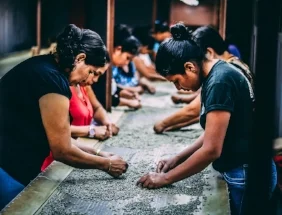Women in the Coffee Industry: Cozying up to Quality and Leadership
By Colleen Luckett
Note: This is Part 1 of a two-part series about gender inequality in the coffee industry and how the industry is addressing these issues.
Over the past two decades, the specialty coffee industry has focused on improving quality and sustainability. But a glaring gap in those efforts tends to be the continuing inequality of female representation and workload, especially on the growing side. Research has overwhelmingly shown that when communities support women, those communities thrive: more children get an education, people are happier in general, there’s less unemployment and poverty, and so on. The word is out: the future is female.
Coffee news website Sprudge.com reports: it’s estimated that eliminating the gap between men and women in access to agricultural resources would increase the yields on women’s coffee farms by 20% to 30% and increase agricultural production in developing countries by up to 4%.
According to the Specialty Coffee Association of America (SCAA) white paper, “A Blueprint for Gender Equality in the Coffee Lands,” four main areas need improvements:
- distribution of labor
- income
- ownership
- leadership and decision making
www.pixabay.com
Female farmers in rural communities suffer from the “double burden” of working in the coffee fields and in the home. While men typically have 8-hour work days, women work an average of 15 hours a day, including field work and household work. Also, women work mostly at the beginning of coffee production—laboring in the field, harvesting, and processing—which is the least influential phase. Men typically transport, market, and reap profits from the product.
www.unsplash.com
According to “Women in Coffee,” published in the International Trade Center’s digital quarterly magazine International Trade Forum in 2008, women made up 70-75% of the total workforce in fieldwork, harvesting, and sorting but only 5-20% of ownership (land, coffee product, and coffee-related companies).
Income: This Cup Is Half Full or Empty
Another card up mens' sleeves: income inequality. Because women usually work for lower wages than men, and in many cases without pay, their contributions to coffee production are sometimes referred to as “invisible.” Men receive the money from the coffee sales, so women have difficulty accessing it. In fact, in some communities, women are known to sell coffee beans directly from their small household plots out of desperation, which can lead to domestic violence. “Traditional” attitudes are also a problem: for example, in Uganda, the prominent attitude is that women should contribute to coffee farming out of duty but shouldn’t share in the crop proceeds.
Ownership is a Male Condition in the Coffee Business
Women make up only 3 to 20 percent of landowners in the developing world, even though they comprise 20 to 70 percent of the agricultural labor depending on the country (U.S. Food and Agriculture Organization, 2011). Official and cultural impediments often support the status quo. For example, in December 2014, Women for Women International reported that the constitution in the Democratic Republic of the Congo (DRC) guarantees women the right to access land, but other legislation inhibits that right. Many women need permission from their husbands, which is often unlikely.
A lot of other legislation in developing countries conflicts with traditions, including making it difficult for women to inherit land even when laws permit it because male relatives inherit farms, not the wives. Credit is not easy to come by for women in these communities. And even when women do own land, they are often allotted smaller, less fertile plots or fewer coffee trees. Much work is needed in harmonizing legislation with tradition.
Leadership and Decision Making Go Mostly to Men
In these “traditional” communities, much of the decision making for the household goes to the men because they own the land. Women are increasingly present at cupping tables, but they’re rarely included as association leaders, farm managers, or owners. In cases where women do manage to obtain leadership positions, they often lack the training or self-esteem to be effective in their roles. Women also rarely have crucial leadership positions in policy-making organizations and representative bodies, such as Ministries of Agriculture and local and regional producer organizations and associations. This is especially problematic, because these very organizations are the ones tasked with bridging the gender gap and bringing more women into the fold.
According to the SCAA white paper, if granted the same access to land, financing, and technology as men, women could increase their agricultural output by 20% to 30%. Imagine what this could do for the whole of the coffee industry—and the world at large.
Note: The second blog in this two-part series will focus on gender-gap solutions created by including more women in coffee farm management and ownership.
Do you have opinions or questions about gender equality in the coffee industry? Please write them in the Comments section below.


